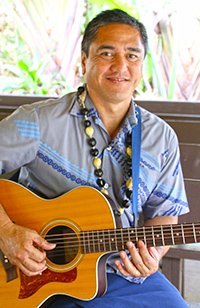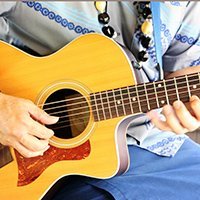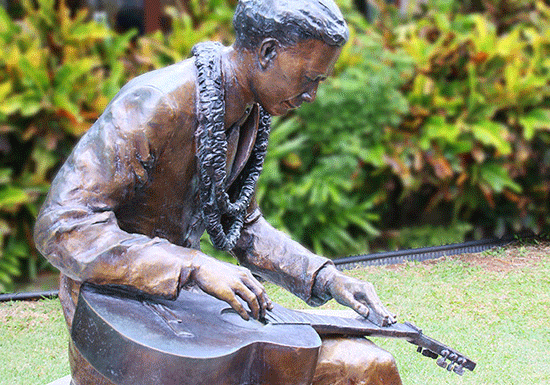Listen up for slack key in the Hawaiian Village
The popularity of Hawaiian music and instruments such as the steel guitar and ukuleles has spread around the world; and so, rightfully, part of the PCC’s cultural presentation in the village focuses on Hawaiian music broadly; and in a smaller slice of that part, if you’re really lucky, you might get the chance to hear Kaipo Manoa play what the Hawaiians call kī ho’alu — slack-key guitar. He’s really good!

Manoa, our PCC Hawaiian Village “chief” who’s originally from Nanakuli, Oahu, grew up listening to slack key guitar, “because my uncle played, but I never played until about 10 years ago. I saw some CDs at my dad’s house back then, borrowed them and learned from there. I already knew how to play guitar, so I just kind of taught myself slack key.”
“Slack key is the way Hawaiians first played the guitar when when it was introduced by the Spanish and Mexican vaqueros or cowboys in the 1800s. As those guitars went out of tune after the vaqueros left, the Hawaiians just re-tuned them to an open chord that kind of followed what they heard the Mexican cowboys play and figure out their own fingering,” Manoa explained.
“While the music those early Hawaiians heard was probably played by several instruments, they tried to recreate it all in one. That’s why in slack key today you get a syncopated alternating bass with the thumb of the right hand, while the other fingers play the accompaniment and the melody all at the same time on a single guitar.”
Manoa, who also teaches a slack key guitar class next door at Brigham Young University Hawaii, pointed out that today there are literally dozens of personalized slack key guitar tunings, but the most common one, called “taro patch,” starts with the standard six-string guitar tuning — EADGBE: “The high and low E strings are lowered [by turning the key] or ‘slacked’ [hō’alu] to D and the fifth string from A down to G. The notes end up at DGDGBD, a G major chord,” he said.
“There are major-chord tunings based on C, F, and D chords. Another important group of tunings, based on major-seventh chords, is called ‘wahine,’ and a third significant group is Mauna Loa tunings, in which the highest pair of strings are keyed a fifth apart.”
“These changes give slack key a really nice, fuller sound with a lot of high-string notes,” Manoa continued. “People in our village demonstrations know it sounds different, and they just love it.”
A Wikipedia entry also lists other slack key harmonics or chiming sounds characteristics, as well as techniques such as:
- The “hammer-on” — created by sharply bringing a fretting-hand finger down on the fingerboard behind a fret, causing a note to sound.
- The “pull-off” — when the fretting finger is pulled off (exposing the string either as open or as stopped by another fretting finger lower on the same string) the note playing on the string changes to the new, longer vibrating length of the string.
- Slides and damping effects.
“It took Hawaiians a long time to figure all of this out,” Manoa said. “Consequently, at one time slack key was kept secret by particular families. They weren’t too eager to share it. Some times after people played slack key, they would re-tune their guitars back to regular settings so nobody could copy their keys.”
Unlike the “boom” in the popularity of Hawaiian music and the ukulele starting in the 1920s, music historians say slack-key guitar remained in this realm of “private, family entertainment” until the second half of the 1940s, when the earliest recordings began to appear; but it was really during the Hawaiian cultural renaissance of the 1970s that slack-key began emerging as a truly unique expression of the Hawaiian spirit . . . especially thanks to the talents of artists such as:
Gabby Pahinui, Atta Isaacs, Leonard Kwan, Sonny Chillingworth, Raymond Kāne; and the more modern styles of younger players such as Keola Beamer, his brother Kapono Beamer, Peter Moon, and Haunani Apoliona.
The Hawaiian renaissance also inspired currently prominent Hawaiʻi-based players such as Cindy Combs, Ledward Kaapana, George Kahumoku Jr., his brother Moses Kahumoku, Dennis Kamakahi, Ozzie Kotani, the three Pahinui brothers — Bla, Cyril, and Martin; the Emerson Brothers and Owana Salazar.

“Today, it’s totally different: It’s all about sharing,” Manoa said. You can go online. You can buy CDs, and the jackets show all the different tunings. This way, we’re keeping slack key alive.” He also pointed out that the first four winners of the Grammy Award for Best Hawaiian Music were slack key collections.
To order your own Hawaiian slack key guitar music, go to our PCC online store. To learn more on your own, Manoa recommends looking up Ozzie Kotani on YouTube, because his videos show tablature and fingering, “and you can play along.”
In the meantime, enjoy Hawaiian slack key guitar in the PCC’s Hawaiian Village.
Story and images by Mike Foley

Mike Foley, who has worked off-and-on
at the Polynesian Cultural Center since
1968, has been a full-time freelance
writer and digital media specialist since
2002, and had a long career in marketing
communications and PR before that. He
learned to speak fluent Samoan as a
Mormon missionary before moving to Laie
in 1967 — still does, and he has traveled
extensively over the years throughout
Polynesia and other Pacific islands. Foley
is mostly retired now, but continues to
contribute to various PCC and other media.


Recent Comments